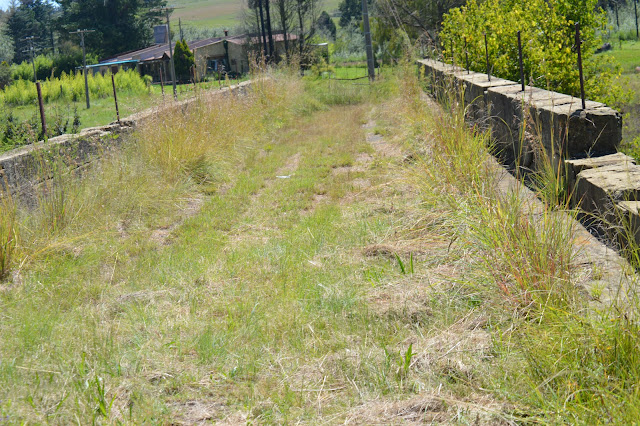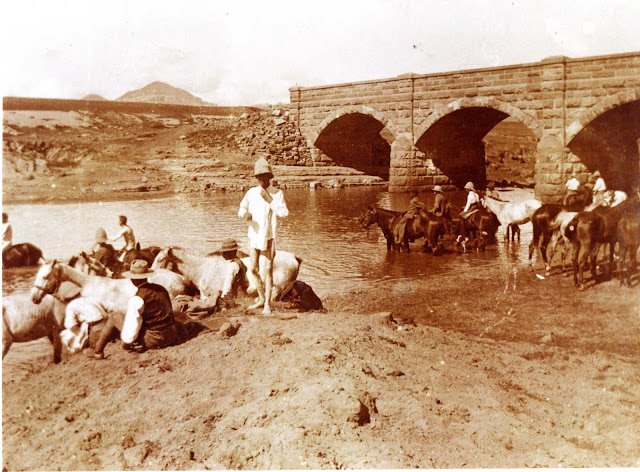This farm school opened its doors in 1934 in a room in my grandparents' house. My Granny – Hester Fincham was very involved with the day to day issues of the school. My parents and family also attended the farm school
Growth was evident and soon my grandfather – Victor Fincham built a school. Till today it is fondly remembered as the ‘Wit Skool” because since I can remember it was painted white.
Mrs Vic (Granny Hester) as she was known in the community was still seeing over the day to day running of the school. During a break, the learners would go to the post office to get the mail. En route to the post-office was Mr Mackay’s shop and here you could buy to huge Wilson toffees for one penny.
Fifty-seven years ago, my brother, Julian headed off to school. This was a huge family celebration as he was the eldest grandchild of Mrs Vic
Front Douglas and Julian. Middle Patric and Francis on Granny’s lap. Back Myself and Elaine
It looked like great fun and he even got to make sandwiches every day too! He had a smart suitcase, BOOKS, CRAYONS AND PAPERS! After not too much persuasion, I went off to school with him. I must have been the first 4-year-old in “Grade 0!”
Our teacher – I can’t remember if it was Miss Betsie or not, but she let me practice writing with the left hand and when that was tired, with the right hand. My mum would come and pick me up at break time soon after all the sandwiches had been devoured.
Front Riana, Maggie, Rita and Amanda. Middle Mariette, Elmarie, Elize, Myself and Ansie Next row Analize, Heila, Marieta, Velmay, Elaine and Ria. Roux, Hanelie, Anina, and Martjie (So sorry I have lost a name) Miss Betsie. Miss Betsie travelled by horse cart to school.
The most memorable thing from that first school year was Julian’s speech about what happened at home just before his leaving for school. I have never quite understood why children must always write a speech or composition about their holiday or what happened at home on a particular day.
Getting back to the story – like most farm children of the day, Ouboet (Big brother) was quite capable of driving the Ford. Hennie says it was a Ford 100. We would catch Uncle Koos’s bus to school. With Ouboet behind the wheel, we would drive to the farm gate and then get onto the bus.
His speech went as follows, “Miss, this morning on the way to school, Ford’s clutch slipped and the gears locked which nearly resulted in us being late for the bus.”
The following year, the school began and it was serious business. I recall Maggie and Elmarie who had the most delicious peach jam sandwiches. The sandwiches were later replaced by the most delicious chocolate cake. Elaine could go home whenever she felt like it. She was also my cousin and I would accompany her home during many a break time. She could run like a streak of lightning. Then there was Marieta and Mariette who could both sing so beautifully. Years later they would even get to sing the Drummer Boy song in the NG Church’s gallery. The clever girls were Heila, Riana and Amanda.


Still remember some of the boys' names Koos Swart, Johan, Evert, Karel, Kosie, Julian, Hennie, Pieter, Henry, Douglas, Patrick, Gertjie, Theo, Pookie, Johnny, Pierre, Diekie, Johannes Mr Olivier is the teacher. Ouboet is standing in the second row from the top just behind Gertjie with the black blazer. Next to Ouboet is Kosie with the badge on his lapel.
It was during this time of my life that I came to meet a certain school inspector. As he walked between the desks, he stopped at my desk. I think it was quite unusual at the time that a child could cope quite well writing with both their left and right hand. Perhaps he had not yet heard of the word ambidextrous! Who would have heard of such a thing back in 1963!
With the following words, “Miss, you had better decide which hand you are going to use to write with!” I got such a fright, I decided to go with the hand in which the crayon was held at the time – it was my left hand. Fortunately, all left-handed people are seen by myself as somewhat special, many of whom happen to be in our family.
I remember Mr Basson – he had his classes in the old white school building. We sat according to our classes. The standard 3’s in front, then 4’s and then the 5’s. As the standards progressed each year, we would move further back too. The thing I remember the most about Mr Basson were his essays. He taught me to write about the mountains. He would write key words on the blackboard and we would have to create a story around them. I always wondered if he were missing the mountains of the Cape Boland as he would spend so much time teaching us about these majestic blue giants. I must say that from where I sit right now, living at the foot of the Platberg, I could even wax lyrical about the colours of this beautiful mountain.
Later on, Andrew would arrive at school with his bandy legs. Like Elaine, he would run so fast you would just spot him disappearing into the distance!
And so, the years marched on. Many of our, “clutches,” would slip and our, “gears,” would jam but at the same time, we learned of the Majesty of God’s Grace and Mercy.
May God’s blessings always fall on the Kameel Primary School like soft and gentle rain.
Till next time
Hennie & Sandra





















































